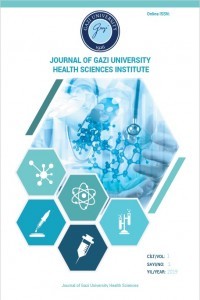The Antioxidant Activities and Total Phenol Contents of Eleven Turkish Medicinal Plants
The Antioxidant Activities and Total Phenol Contents of Eleven Turkish Medicinal Plants
In this study, we assessed antioxidative activities and total phenol contents of Achillea biebersteinii, A. setacea, Anthemis pseudocotula, A. tinctoria var. tinctoria, Artemisia austriaca, Cistus laurifolius, Nepeta italica, Paliurus spina-christi, Primula vulgaris, Rubus sanctus, and Salvia verticillata used as folk medicine in Anatolia. The antioxidant activities of decoctions or infusions prepared from plants were evaluated by in vitro models including, ABTS radical scavenging assay, metal chelating assay, and ferric reducing power. Except for A. tinctoria var. tinctoria infusion in reducing power capacity assay and P. spina-christi decoction in metal chelating activity, all extracts displayed high antioxidant activity in all three antioxidant assays. In particular, C. laurifolius infusion showed a potent antioxidant effect as well as all references used to evaluate activity. The phenol contents of the extracts were in the range 262.70 ± 2.06-48.10 ± 0.68 mg gallic acid equivalent/g extract. The findings justify folkloric use of these plants used in the treatment of diseases such as colds, cough, colds, tonsillitis and bronchitis.
Keywords:
Antioxidant activity total phenol content, medicinal plant,
___
- Akgul C., & Saglikoglu G. (2005). Antibacterial activity of crude methanolic extract and its fractions of aerial parts of Anthemis tinctoria, Indian Journal of Biochemistry and Biophysics, 42, 395-397.
- Askun T., Tumen G., Satil F., & Ateş, M. (2009). Characterization of the phenolic composition and antimicrobial activities of Turkish medicinal plants. Pharmaceutical Biology, 47, 563-571,
- Baratta M.T., Dorman H.J.D., Deans S.G., Figueiredo A.C., Barroso J.G., & Ruberto G. (1998). Antimicrobial and antioxidant properties of some commercial essential oils. Flavour and Fragrance Journal, 13, 235-244.
- Başer, K.H.C., Tümen, G., Malyer, H., & Kırımer, N. (2006). Plants used for common cold in Turkey, Poster session presented at the IVth International Congress of Ethnobotany (ICEB 2005), İstanbul, TR.
- Chalchat J.C., Michet A., & Pasquier B. (1998). Study of clones of Salvia officinalis L. yields and chemical composition of essential oil. Flavour and Fragrance Journal, 13, 68-70.
- Dinis T.C.P., Madeira V.M.C., & Almeida L.M. (1994). Action of phenolic derivatives (acetaminophen, salicylate and 5-aminosalycilate) as inhibitors of membrane lipid peroxidation and as peroxyl radical scavengers. Archives of Biochemistry and Biophysics, 315, 161-169.
- Formisano C., Rigano D., & Senatore F. (2011). Chemical constituents and biological activities of Nepeta species. Chemistry & Biodiversity, 8, 1783-1818.
- Güner ND (2005). Paliurus spina-christi Mill. Üzerinde Farmakognozik Araştırmalar, MSc, Hacettepe University Institute of Medical Sciences, Ankara, Turkey.
- Hartl A., & Vogl C.R. (2003). The potential use of organically grown dye plants in the organic textile industry: experiences and results on cultivation and yields of Dyer’s Chamomile (Anthemis tinctoria L.), Dyer’s Knotweed (Polygonum tinctorium Ait.), and Weld (Reseda luteola L.). Journal of Sustainable Agriculture, 23(2), 17-40.
- Kurtulmus A., Fafal T., Mert T.A., Saglam H., Kivcak B., Ozturk T., Demirci B., & Baser K.H.C. (2009). Chemical composition and antimicrobial activity of the essential oils of three Anthemis species from Turkey. Chemistry of Natural Compounds, 45, 900-904.
- Oyaizu M. (1986). Studies on products of browning reactions antioxidative activities of products of browning reaction prepared from glucosamine. The Japanese Journal of Nutrition and Dietetics, 44, 307-315.
- Öksüz S., Gümüş S., & Alpınar K. (1991). Sesquiterpenoids and flavonoids of Achillea species. Biochemical Systematics and Ecology, 19(5), 439, 1991.
- Re R., Pellegrini N., Proteggente A., Pannala A., Yang M., & Rice-Evans C. (1999). Antioxidant activity applying an improved ABTS radical cation decolorization assay. Free Radical Biology & Medicine, 26(9-10), 1231-1237.
- Sengul M., Ercisli S., Yildiz H., Gungor N., Kavaz A., & Çetin B. (2011). Antioxidant, antimicrobial activity and total phenolic content within the aerial parts of Artemisia absinthum, Artemisia santonicum and Saponaria officinalis. Iranian Journal of Pharmaceutical Research, 10(1), 49-56.
- Sezik E., Zor M., & Yeşilada E. (1992). Traditional Medicine in Turkey II. Folk Medicine in Kastamonu. International Journal of Pharmacognosy, 30, 233-239.
- Sharma M., & Joshi S. (2011). Comparison of antioxidant activity of Andrographis paniculata and Tinospora cordifolia Leaves. Journal of Current Chemical and Pharmaceutical Sciences, 1(1), 1-8.
- Singleton V.L., Orthofer R., & Lamuela-Raventos R.M. (1999). Analysis of total phenols and other oxidation substrates and antioxidants by means of Folin-Ciocalteu reagent. Methods in Enzymology, 299, 152–178.
- Stępień A., Aebisher D., & Bartusik-Aebisher D. (2018). Biological properties of Cistus species. European Journal of Clinical and Experimental Medicine, 16(2), 127-132.
- Süntar İ., Koca U., Keleş H., & Küpeli Akkol E. (2011). Wound healing activity of Rubus sanctus Schreber (Rosaceae): preclinical study in animal models. E-CAM: doi:10.1093/ecam/nep137.
- Ustun O., Ozcelik B., & Baykal T. (2016). Bioactivities of ethanolic extract and its fractions of Cistus laurifolius L. (Cistaceae) and Salvia wiedemannii Boiss. Pharmacognosy Magasine, 12(Suppl 1), 82-85.
- Uttara B., Singh A.V., Zamboni P., & Mahajan R.T. (2009). Oxidative stress and neurodegenerative diseases: A review of upstream and downstream antioxidant therapeutic options. Current Neuropharmacology, 7(1), 65–74.
- Ünal M., Yentür S., Cevahir G., Sarsağ M., & Kösesakal T. (2003). Physiological and anatomical investigation of flower colors of Primula vulgaris L. Biotechnology & Biotechnological Equipment, 17, 102-108.
- Wu C., Chen F., Wang X., Kim H., He G., Haley-Zitlin V., & Huang G. (2006). Antioxidant constituents in feverfew (Tanacetum parthenium) extract and their chromatographic quantification. Food Chemistry, 96, 220-227.
- Yeşilada E., Honda G., Sezik E., Tabata M., Goto K., & Ikeshiro Y. (1993). Traditional medicine in Turkey IV. Folk medicine in the Mediterranean subdivision. Journal of Ethnopharmacology, 39, 31-38.
- ISSN: 2687-6353
- Yayın Aralığı: Aylık
- Yayıncı: Gazi Üniversitesi
Sayıdaki Diğer Makaleler
The Antioxidant Activities and Total Phenol Contents of Eleven Turkish Medicinal Plants
Didem Deliorman Orhan, Sanem Hoşbaş Coşkun
Autism Spectrum Disorder, Microbiota And Nutritional Therapy Approaches
Şehriban DUYAR ÖZER, Gülçin SAĞDIÇOĞLU CELEP
